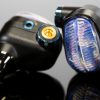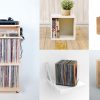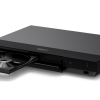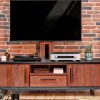Growing up, Hockey Night in Canada would run a competition during the intermission called “Showdown.” The weekly segment would feature two NHL superstars who were pitted against one another in a series of skills competitions and whilst it may seem rather boring today — it created serious Monday morning bragging rights at the rink for those of us who wore a specific jersey.
It also sold truckloads of foam targets that we struggled to attach to our rusted hockey nets in the driveway.
Some form of competition never harmed anyone. It was the only way to improve our performance.
Whilst listening to some new Blue Note Tone Poet releases recently, I was struck by the fact that I own far too many turntables and that I need to use them in a more constructive fashion; some of them are starting to gather dust which is a shame because there are some excellent cartridges on them.
Over the past decade, it has also come to my attention that high-end publications have a weird sense of gear fetishism as it pertains to phono cartridges; and don’t think I have not spent the time listening to some impressive cartridges from Miyajima, Dynavector, Lyra, or Koetsu myself — I just don’t see the point in buying one.
I would like to think that I represent the majority of audiophiles who have a budget that hits a ceiling around $500.
I have heard all of the arguments in regard to extracting 100% of the information inside the grooves but none of them sway me enough to spend $5,000 or even $2,000 on a phono cartridge.
Build a record collection with that kind of money.
The Land of Milk, Braai and Phono Cartridges?
On a recent flight out of the country, there was a lot of time to think about what my future home might look like and how much space there would be for not only all of the hi-fi and home theater equipment that I own — but also the books, movies, and music.
Having made the decision to keep my home in New Jersey until all 3 kids are out, I am not in rush to sell anything quite yet — but the home in Israel or South Africa will likely only have room for two turntables.
Life in the land of milk and honey or Springboks comes with some space limitations based on the rather high cost of living.
Having a $500 budget also helps.
Let the 2024 phono cartridge showdown commence.
The System


The Cambridge Audio Evo 150 Network Amplifier does include a rather workable MM phono section, but for the purposes of the showdown, I decided to inject my Pro-Ject Tube Box DS2 and Moon by SimAudio LP110 V2 into the mix to extract the best possible performance from the 3 cartridges.
Loudspeakers included the Q Acoustics 5040 and Wharfedale Diamond 10.1s; which were also augmented with a REL T/5x subwoofer.
Turntables included the NAD C 588, Pro-Ject X2 B, Pro-Ject Debut Pro, and Yamaha YP-701; which are suitable decks for the Goldring E4, Grado Labs Timbre Opus3, and Sumiko Blue Point No. 3 phono cartridges.
Sumiko Blue Point No. 3

Eric Pye did a wonderful job reviewing the Blue Point No. 3 and his observations about its pacing and organic nature piqued my interest. We both share a similar obsession with jazz music and he’s never steered me wrong in regard to great music suggestions.
Eric ran the Sumiko on a vintage Denon DP-1200, whilst I chose to run the Blue Point No. 3 on both Pro-Ject tables and ultimately felt that the more expensive X2 B was a marginally better platform.
The new Blue Point No. 3 cartridges were announced in June 2021, replacing the best-selling Blue Point No. 2, for an affordable ($499.00 each) MC design that produces great detail and stereo separation.
Both cartridges benefit from a new shell design, with a smoothly bevelled front fascia allowing excellent visibility of the stylus tip when mounting.
Pro-Ject offers the Blue Point No. 3 in both high output (2.5mV) and low output (0.5mV) versions.
The high output version is similar to my Dynavector 10×5 in that regard and whilst it has always worked rather well with my Croft Phono RIAA Phono Stage (42dB of gain) — it was clear that the Sumiko needed a few extra clicks on the volume control to reach the levels that I enjoy.
Grado Labs Timbre Opus3

The Opus3 is nestled inside a Maple housing (8 grams) and I discovered that it sounded the best on the vintage Yamaha YP-701 and the replacement Ortofon LH-2000 Headshell that I ordered during the pandemic for another cartridge.
The cantilever is made from aluminum and the Opus3 uses an elliptical diamond stylus; mounting the cartridge was quite easy and I settled on a tracking force of 1.8 grams which was within the range but closer to the very top.
Grado offers multiple versions of the Opus3 including the high output (4mV) version supplied, a low output model (1.0mV), and a mono version as well.
The higher output of the Opus3 makes it compatible with a wider range of integrated amplifiers that include a phono section, but make no mistake — this is one MI (Moving Iron) cartridge that really benefits from something like the Pro-Ject or Moon by SimAudio phono stages.
The Grado “house” sound is certainly present, but the Opus3 represents somewhat of a departure for the Brooklyn-based manufacturer.
The midrange is certainly warmer sounding than the Sumiko and Goldring, but the clarity and detail are not typical of a wood body Grado.
The bottom end has enough punch with pop and electronic music to keep one engaged and the treble does not roll-off as quickly compared to older models.
Goldring E4

The Goldring E4 is designed to be compatible with all medium-to-high-mass tonearms of the type found on the majority of budget to midrange turntables. And because it’s constructed using the same high-quality core as the other E Series cartridges in the range, E4 is ideal both for those who wish to upgrade an obsolete cartridge in its entirety or those who want to boost the performance of their existing E Series cartridge by replacing the stylus.
The E4 offers 3.5mV of output which is on the lower side for MM cartridges but it proved to be sufficient with the Pro-Ject Phono Tube Box D2, and Cambridge Audio Evo 150 Integrated Amplifiers.
With so much competition below $300, the Goldring E4 had to eclipse the performance of the previous generation E3 to remain competitive but also deliver something that the competition does not.
There is no question that the E4 offers a higher level of resolution and refinement than that of its predecessor and superior top end detail retrieval that never becomes strident.
The tonal balance is similar but there is some additional presence in the upper midrange that makes this a more engaging listen.
Goldring recommends a tracking force of 1.75 grams for the E4 and that proved to be accurate with the C 588 table, but I did have to go to 1.85 on the Yamaha.


Showdown in the Shuk
Listening to Lee Morgan’s The Sidewinder, and Stanley Turrentine’s Hustlin’ proved to be rather informative; all 3 cartridges reproduced of the timbre and presence of horns extremely well but the similarities ended there.
The Goldring offers a somewhat harder and more precise edge compared to the Grado and Sumiko that are hazier in that regard.
The Opus3 strips away some detail compared to the other two cartridges, but it delivers a firmer bottom end with almost every genre.
The Sumiko and Goldring both deliver more top end energy; treble detail with the Blue Point No. 3 is airy and very smooth giving percussion just enough edge without ever becoming strident.

The E4 is the clearest sounding of the three creating a very open sounding presentation with jazz recordings and whilst some might find its precise nature and cooler tonal balance somewhat more aggressive — the Goldring does let one hear every last detail on a recording.
Listening to Ella Fitzgerald and Billie Holiday with all 3 confirmed a few more notable observations about their performance.
The Goldring might deliver the most clarity and insight; but the Grado has more mid bass and midrange punch; not to mention a lot more texture giving each performer greater presence in the room.
The E4 lets you hear Billie and Ella; the Opus3 and Blue Point No. 3 allow you to feel them as well.
Tempo is a strength of all 3 and I can’t see any fan of jazz not enjoying the pace and quick nature of the sound.
The Sumiko and Grado add additional weight to instruments; bass and the piano sound fuller overall and whilst you lose some of the edge of notes, the texture, timbre, and strong dynamic capabilities are a trade-off worth keeping.
Dead of Night
Because of my erratic travel schedule over the past 3 months and a rather unfortunate bout of the flu, a lot of my listening lately has been in the dead of night.
It has sadly become easier for me to listen whilst the kids and Tyrion are sleeping; the one negative is that I am noticing every last noise in the house at that time which can be distracting.
I rather enjoy Orville Peck and whilst he bailed on his concert in August scheduled for Asbury Park due to medical issues, he’s been getting a lot of time with me again during these very stressful weeks since October 7th.
His baritone delivery is distinct and it was my hope that “Dead of Night,” “The Curse of the Blackened Eye,” and “Let Me Drown” off his Pony and Bronco releases would separate the boys from the men.
The E4 pushed all 3 tracks further ahead of the instrumentation, and that would have been fine had it not also exposed a small degree of stridency in the top end as strings and the percussion kicked in.
Peck’s presence is rather extraordinary; not to mention his dynamic range that puts many of his peers to shame.

The Grado hit the hardest in the low end with all 3 tracks; bass notes had both excellent extension and impact on records with some traces of compression.
Sumiko gets the trophy here for smoothness and stereo separation, but the Grado captured the unique variations in his delivery best and the rapid changes in tempo throughout.
Whip It
Returning stateside, I had to do some digging to find a rather old copy of Freedom of Choice and it was the perfect album to give all cartridges some difficulty.
Grado builds cartridges that excel with rock and new wave music and there was no point during this album that the Goldring or Sumiko challenged its sense of swagger or low end punch.
The E4 cleans things up extremely well and it did reproduce “Whip It” and “Gates of Steel” with a greater sense of clarity and spaciousness; the Grado sacrifices some soundstage width and depth for its more powerful presentation and texture.

The Blue Point No. 3 positioned itself in the middle of the pack with most rock and new wave recordings; very open, smooth, and ripe with texture and detail.
It could also be a little soft in the low end, but it does great things with both male and female vocals.
Amy Winehouse’s “Valerie” can come across as somewhat etched if your amplifier and loudspeakers favour neutrality and a brighter sounding top end.
The Sumiko and Grado were noticeably thicker in the upper midrange and lower treble, and whilst that also came with the late-singer taking a step back in the soundstage compared to the Goldring — it presented her with an extra layer of texture and grit that was her trademark.
Taylor who?
Final Thoughts
I suppose it all depends on what you are looking for; drama or a more cerebral listen?
The Goldring E4 is a fantastic tracker, easy to install, and the most revealing of the 3 cartridges. Detail retrieval is another strength but it can be too much of a good thing if the rest of the system leans that way as well.
If your system already has a darker tonal balance and you require something that will illuminate your music collection — this is a tremendous value.
The Grado Timbre Opus3 is the least expensive model in the wood body series and overachieves in every possible way with one of the most open sounding and detailed presentations you will find at its price.
The low end delivers a heavier punch than either of its competitors and the midrange texture does wonders for lean sounding turntables and systems.
So where does that leave the Sumiko Blue Point No. 3?
Superb stereo separation combined with the most natural sounding detail is a huge selling point.
The bass range is tight and quick, but delivered with less impact than its rival from Brooklyn.
With a tonal balance that is somewhere in-between the Goldring and Grado, the Japanese cartridge is likely the best all-around for those looking for detail, texture, pacing, and overall top end performance.
Impossible to go wrong with any of these considering their performance and value for the money.
Where to buy:
- Goldring E4 – $299 at Amazon
- Grado Timbre Opus3 – $300 at Amazon
- Sumiko Blue Point No. 3 – $499 at Amazon
Related Reading:









































Ian
January 14, 2024 at 11:10 am
Great review, I actually already have the Grado Opus3 and the Goldring E3 – I’m shortly going to pick up an E4 stylus for it. The price for the Sumiko in the UK is currently £550 – for that reason I think it makes the Goldring and Grado clear winners.
Ian White
January 14, 2024 at 7:56 pm
Ian,
Solid name. 😉
I agree that the higher price of the Sumiko puts it out of reach for many people, but I will also say that its performance justifies the pricing. It’s a very underrated cartridge. It gets even better when used on a deck with balanced connections and a balanced phono pre-amplifier.
All 3 are great carts.
Best,
Ian White
David Archambault
January 15, 2024 at 1:23 am
Hana EL/EH deserves consideration.
Ian White
January 15, 2024 at 3:47 pm
Dave,
Great to hear from you. It does but Hana needs to respond to requests for review samples. 😉
Ian
lash
January 21, 2024 at 3:55 am
Be serious. The Denon 301 Mk 2 will destroy any of these.
Ian White
January 21, 2024 at 2:23 pm
Lash,
I don’t need to be “serious.” I need to report on what manufacturers make available.
I’ve owned a DL-103 for years. I love it. Never tried the 301 MK 2.
Nothing destroys anything anymore.
Best,
Ian White